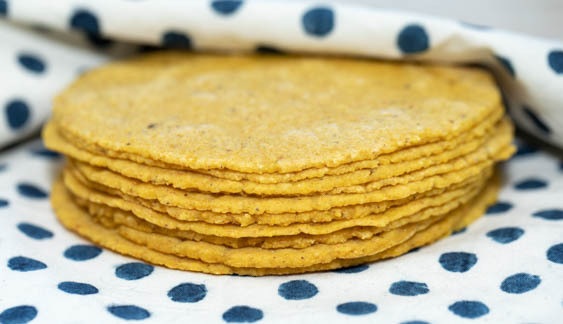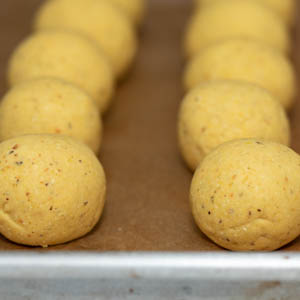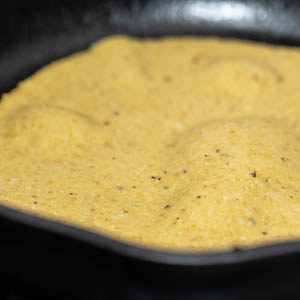Spring Water Masa Tortillas

introduction
Nine times out of ten, “fresh” corn tortillas are made with instant masa or Maseca (corn flour ground from dried hominy) and water, rather than from whole hominy ground into masa. Appealingly supple though they may be, the over-nixtamalized dough takes an acrid turn on the palate, eclipsing the nuances of fresh masa. Tortillas made from fresh whole hominy, like these, bring subtle layers of spice and floral notes to the flavor of fresh sweet corn. They are incomparably better than their instant masa competitors.
Cooking Remarks
It isn’t difficult to roll out tortillas with a rolling pin between sheets of thick plastic. But it is much, much easier to make them with a tortilla press.
Tortillas are traditionally cooked without fat, and you will not need fat to cook these.
As they come off the griddle, stack the tortillas and cover them with a clean, damp towel or hold them in a covered baking dish. Though fresh-made corn tortillas are considered daily food—meant to be prepared and consumed the same day—a day or two in the fridge won’t kill them, particularly when you’re going for a crisp taco or chip.
equipment mise en place
For this recipe, you will need a rimmed baking sheet, parchment paper, a digital kitchen scale, a well-seasoned cast-iron griddle, a tortilla press plus a quart-size zipper-lock plastic bag or a rolling pin plus a gallon-size zipper-lock plastic bag, a pair of scissors, a ruler, and a thin metal spatula.
-
-
1recipe Spring Water Masa
-
-
Line a rimmed baking sheet with parchment paper. Divide the masa into 1.5-ounce pieces and r0ll each piece between your palms into a ball. Set the balls on the prepared baking sheet (fig. 1.1) and cover lightly with plastic wrap.
-
Heat a well-seasoned cast-iron griddle over medium-high heat. If using a tortilla press, use scissors to trim off the top of a quart-size zipper-lock plastic bag, cutting just below the seal. Snip along the two side seams and the bottom, creating 2 squares of plastic. If using a rolling pin, cut apart a gallon-size zipper-lock plastic bag in the same manner.
-
If using a tortilla press: Open the press, place one of the plastic sheets on the bottom plate, set a masa ball on the plastic, and lay the second plastic sheet on the top. Close the tortilla press with moderate pressure. Open the press and pull off the top layer of plastic. The tortilla should be 5 inches in diameter. If it is smaller, give it a bit more pressure in the press. Lift the bottom sheet of plastic and invert the tortilla onto your palm (fig. 3.1). Release the tortilla onto the hot griddle and cook for 10 to 15 seconds. If the griddle is the correct temperature, the tortilla should puff a bit (fig. 3.2). Use a thin metal spatula to flip the tortilla; it will be lightly golden (fig. 3.3). (Don’t overcook the tortillas at this point if you intend to rewarm them later.) As the tortillas come off the griddle, stack them on top of each other. Repeat with the remaining masa balls. (Alternatively, you can press all the tortillas and stack them between squares of parchment paper before griddling.)
-
If hand-rolling the tortillas: Place one of the plastic sheets on the counter, set a masa ball on the plastic, and lay the second plastic sheet on top. Using a rolling pin, roll the ball into a 5-inch round of even thickness. Lift the bottom sheet of plastic and invert the tortilla onto your palm. Release the tortilla onto the hot griddle. Cook for 10 to 15 seconds. If the griddle is the correct temperature, the tortilla should puff a bit. Use a thin metal spatula to flip the tortilla; it will be lightly golden. (Don’t overcook the tortillas at this point if you intend to rewarm them later.) Repeat with the remaining masa balls.
-
-
1.1

-
-
-
3.1

-
3.2

-
3.3

-